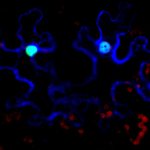Plant Genetic Transformation Mechanisms Emerge
Media Contact:
Jennifer Martin, (202) 720-8188
By Stacy Kish, CSREES Staff
August 4, 2008

Direct interaction between the plant VIP1 protein and the bacterial Virulence E2 protein component of the Agrobacterium T-complex in the host cell nucleus as detected by bimolecular fluorescent complementation and laser scanning confocal microscopy.
Credit:
Vitaly Citovsky
Scientists are unlocking the process of how bacteria transfer genetic material into the plant genome. This information may lead to crop plants with improved resistance to pests and disease.
With funding from USDA's Cooperative State Research, Education, and Extension Service (CSREES), a project team in New York systematically investigates and uncovers fundamental biological principles behind the action of Agrobacterium, which is known for its ability to transfer DNA between itself and plants, making it an important tool for genetic engineering.
Agrobacterium serves as both a genetic engineering tool for crop production and an experimental system to study basic cellular reactions in genetic transformation. It represents the only known natural example of how genetic information can be transferred between different kingdoms of life, in this case from bacterium to plants. In nature, Agrobacterium promotes uncontrolled growth of cells in the infected plants. In the hands of scientists, it serves as a living nanomachine for genetic transformation of plants in biotechnology industry and research laboratories.
To genetically transform plants, Agrobacterium transports its genetic material, in a form of a nucleic acid-protein complex termed the T-complex, into the host cell nucleus. Once inside the nucleus, the T-complex must reach the host chromosomes to complete the integration into the genetic material of the host cell. Agrobacterium employs a diverse number of biological processes to genetically transform the host cell. This makes it a unique model system to examine genetic material transport between bacteria and eukaryotic cells, cells with internal structures enclosed in membranes. It also works as a model for the transport of genetic material into the cell nucleus.
Vitaly Citovsky and colleagues at the State University of New York at Stony Brook, demonstrated that the plant protein VIP1 helps transfer the invading bacterial T-complex into the host cell nucleus. Then, VIP1 targets the T-complex to the integration site in the plant genome. The targeting process occurs from the direct interaction of VIP1 with the host nucleosomes, the protein-DNA structures that make up chromosomes.
Having arrived to the host chromosome, the T-complex must lose its coat of protein components to allow T-DNA integration. The Citovsky team showed that this uncoating likely occurs when the T-complex proteins begin to decompose; the research team identified bacterial and plant factors that make this decomposition possible. These experiments also revealed that many of the cell functions involved in the genetic transformation process are mimicked and/or augmented by bacterial virulence proteins exported into the host cell.
"Besides this important contribution to our understanding of the Agrobacterium-mediated genetic transformation of plant cells, our work has practical implications for agriculture," Citovsky said.
Using Agrobacterium, the studies discovered proteins essential for the transformation process that may facilitate genetic manipulation of crops that are currently difficult to transform. On the other hand, this knowledge is also critical for production of agronomically important plants resistant to Agrobacterium, Citovsky said.
CSREES funded this research project through the National Research Initiative's Developmental Processes of Crop Plants program. Through federal funding and leadership for research, education and extension programs, CSREES focuses on investing in science and solving critical issues impacting people's daily lives and the nation's future. For more information, visit www.csrees.usda.gov.
###
Last Updated: 08/04/2008





